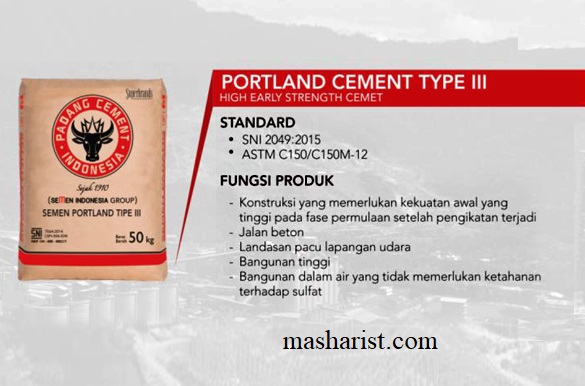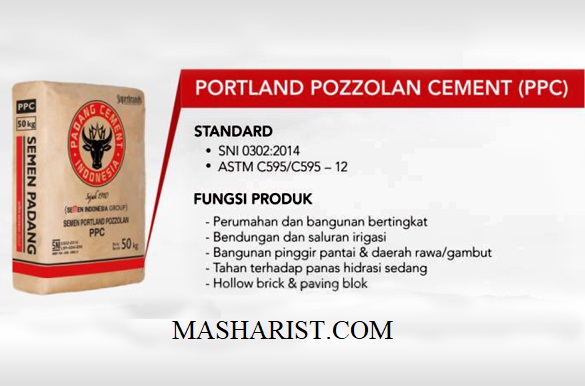Different Types of Cement, Functions and Their Standards
Cement is one of the most used material in construction. Did you know?
Not all the cement are the same, there is various types of cement used in construction.
There is different types of cement, functions and standards.
Okay let's check it out.
 |
| Different Types of Cement, Functions and Their Standards |
Definition of portland cement according to merriam-webster is a hydraulic cement made by finely pulverizing the clinker produced by calcining to incipient fusion a mixture of clay and limestone or similar materials .
- Portland Cement Type I –Ordinary Portland Cement (OPC)
According to ASTM C150 this type of cement for use when the special properties specified for any other type are not required.
This type of cement is very easy to find. it is commonly used for residential construction work, residential houses, roads and high-rise buildings.
This characteristic of Portland Cement Type I is that it does not require special requirements on heat hydration and also initial compressive strength.
This type is very suitable for use in construction projects that are far from sea or coastal areas and have low levels of sulfate.
 |
| Portland Cement Type I –Ordinary Portland Cement (OPC) |
- Common construction for all quality concrete
- Highway concrete structures
- Residential houses
- High rise housing and buildings
- Air plane Runaway
- Bridge structure
- Concrete road structure
- Building components:
pile cap, hollow brick, paving block
Type IA – same as Type I, but when air entrainment is desired
- Portland Cement Type II – moderate sulfate resistance
Portland Cement Type II is used for concrete construction work, in areas with moderate levels of sulfate (soil and water on site contain sulfuric acid ranging from 0.08% to 0.17% or containing SO3 + 125 ppm) as well as moderate hydration heat and applied for construction required special clauses.
This type of cement is used for construction work such as seafront buildings, buildings on / former swampy land, docks, mass concrete irrigation channels for dams, and bridge platforms.
- Seafront building
- Docksbuildings in swampy, peaty and seaside land
- Mass concrete irrigation channels for dams, and bridge platforms.
- Type IIA – same as Type II, but when air entrainment is desired
- Type II(MH) – much like Type II, but when moderate heat of hydration is desired
- Type II(MH)A – same as Type II(MH), but when air entrainment is desired
 |
| Portland Cement Type II – moderate sulfate resistance |
- Portland Cement Type III – for high early strength
Portland Type III Cement provides high strengths at early period of time.
The strength of Portland Cement Type III is equal to 28 days Portland Cement Type I.
This type of cement is used for tall buildings, concrete/rigid pavement, Highways, as well as constructions that require high early strength at an early period, usually a week or less.
- Building
- Concrete/Rigid Pavement
- Highways
Type IIIA — same as Type III, but when air entrainment is desired
 |
| Portland Cement Type III – for high early strength |
- Portland Cement Type IV – for low heat of hydration
Portland Cement Type IV cement is used for construction that requires rate and amount of heat generated must be minimized.
This type also known as a low heat hydration cement.
Where in use, construction should minimize hydration of heat during the curing process.
This type intended for use in massive concrete/ large structure such as dam and/or where excessive heat rise could cause cracking due to volume change.
Please note, this type develops strength at a slower rate than Portland Cement Type I .
- Portland Cement Type V – for high sulfate resistance
The characteristic of Portland Cement Type V is it has a high sulfate resistance more than 0,20%.
It is commonly used for construction in areas with high levels of sulfuric acid such as swamps, mining areas, as well as beaches and seas.
Buildings made include dams, ports, underwater construction to nuclear plants.
- Installation building of waste treatment factory liquid
- Construction under sea surface or peat
- Bridge, tunnel and jetty

Portland Cement Type V – for high sulfate resistance
- Portland Pozzolan Cement (PPC) According to ASTM C595/595M-12 and SNI 15-0302-2004
Some definition from ASTM C595/595M and SNI 15-0302-2004 :
- Binary Blended cement a blended hydraulic cement consisting of portland cement with either a slag, a pozzolan, or a lime stone.
- These cements are classified into two types: Type IS which is portland blast-furnace slag cement and Type IP which is portland-pozzolan cement. They can also be described according to air-entraining, moderate sulfate resistance, moderate heat of hydration, high sulfate resistance, or low heat of hydration properties.
- Portland Pozzolan Cement is a hydraulic cement consisting of an intimate and uniform blend of portland or portland blast furnace slag cement and fine pozzolan produced either by intergrinding portland cement clinker and pozzolan, by blending portland cement or portland blast-furnace slag cement and finely divided pozzolan, or a combination of intergrinding and blending, in which the pozzolan constituent is up to 40 mas % of the portland-pozzolan cement.
- High rise housing and building
- Barrage, jetty and irrigation building
- Building at peat area and ashore
- Resistant to medium hydration temperature
- Building component:
hollow brick and paving block
 |
| Portland Pozzolan Cement (PPC) According to ASTM C595/595M-12 and SNI 15-0302-2004 |
- Oil-well Cement according to API Spec. 10 A, 24 edition, December 2010 and SNI ISO 10426.1:2008
Oil well cement is a special cement that used for crude oil and natural gas construction.
It is used for cementing work with high temperatures and pressures.
It can be used in underwater or underground oil well construction.
 |
| Oil-well Cement according to API Spec. 10 A, 24 edition, December 2010 and SNI ISO 10426.1:2008 |
- Ordinary Portland Cement (OPC)
Ordinary Portland Cement (OPC) also known as Portland Cement Type I.
It's commonly used for all kinds of construction.
- Portland Composite Cement (PCC)
the hydraulic binder resulting from grinding together with portland cement slag and gypsum with one or more inorganic materials, or the result of mixing cement powders portland with other powdered inorganic materials.
These inorganic materials include slag blast furnace (blast furnace slag), pozolan, silicate compounds, limestone, with total content inorganic material 6% - 35% of the mass of portland composite cement
- Portland Pozzoland Cement (PPC)
Portland Pozzolan Cement is a hydraulic cement consisting of an intimate and uniform blend of portland or portland blast furnace slag cement and fine pozzolan produced either by intergrinding portland cement clinker and pozzolan, by blending portland cement or portland blast-furnace slag cement and finely divided pozzolan, or a combination of intergrinding and blending, in which the pozzolan constituent is up to 40 mas % of the portland-pozzolan cement.
- Rapid Hardening Cement
Rapid Hardening Cement (RHC) also known as high early strength cement. RHC has a large proportion of lime than Ordinary Portland Cement (OPC).
The strength of 7 days OPC equivalent to the 3 days strength of rapid hardening cement.
This is because the cement has a higher proportion of tri-calcium silicate (C3S) and lime.
- Quick Setting Cement
Quick Setting Cement is a special type of cement, where the setting time sets earlier and the cement is to be less.
The different between RHC (Rapid Hardening Cement) and Quick Setting Cement is that quick setting sets earlier.
- Low Heat Cement
Low heat cement also known as Portland Cement Type IV.
This cement contains below 6% of Tricalcium aluminate (C3A) and 46% of dicalcium silicate (C2S).
This type intended for use in massive concrete/ large structure such as dam and/or where excessive heat rise could cause cracking due to volume change.
Please note, this type develops strength at a slower rate than Portland Cement Type I
- Sulfates Resisting Cement
It is commonly used for construction in areas with high levels of sulfuric acid such as swamps, mining areas, as well as beaches and seas.
Buildings made include dams, ports, underwater construction to nuclear plants.
This cement has reduced the contents of C3A and C4AF
- Blast Furnace Slag Cement
According to SCA (Slag Cement Association) Slag cement is a hydraulic cement formed when granulated blast furnace slag (GGBFS) is ground to suitable fineness and is used to replace a portion of portland cement.
- High Alumina Cement
High Alumina Cement also known as aluminate cement (CAC) or aluminous cement.
It is can be obtained by manufactured limestone or chalk and bauxite.
- White Cement
In the manufacturing process, White cement process as same as the grey.
However, the selection of raw material is an important part of the process.
The raw material such as oxides of chromium, iron, manganese, nickel and etc are kept at low percentage.
But limestone and clay is used as prominent.
White cement used for exterior and interior architecture building decoration.
- Coloured Cement
Coloured cement can be obtained or made by grinding 5-10% of colours pigment to white cement or Ordinary gray portland cement (OPC).
The function of this cement is for decorative purposes.
- Air Entraining Cement
Air Entraining Cement is special cement produced by adding indigenous air-entraining agents.
The manufacture of this type of cement is same as ordinary cement, however in the grinding process they added some air entraining materials to cement clinkers.
This maskes the cement as air entrained cement
- Expansive Cement
Expasive cement is the type of cement thay expands slightly when mixed with water and does not shrink during and after setting time.
The expansion of the cement mortar or concrete is compensated for the shrinkage losses.
This cement used for grouting anchor bolts and prestressed concrete ducts
- Hydrographic Cement
This type of cement is obtained by grinding portland cement clinker and water-repelling chemicals in order to reduce rate of deterioration.
Hydrographic Cement commonly used in water construction such as dam, water tanks, and etc.
- Oil-well Cement
Oil well cement is a special cement that used for crude oil and natural gas construction.
It is used for cementing work with high temperatures and pressures.
It can be used in underwater or underground oil well construction.
Thanks for reading, this is my first english article. Don't be shy to give me some advice. ☺
Post a Comment for "Different Types of Cement, Functions and Their Standards"